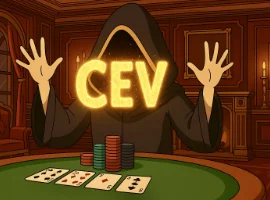By now, you have a solid grasp of Spin structure, rake, CEV, and you feel ready to start grinding.
You play for two weeks and then… this happens:

Ouch — your poker bankroll goes up in smoke. Has Poker Sciences been lying to you?
Not exactly. This graph is misleading, and for one simple reason: In poker — whether you're playing MTTs, Spins, or even cash games — short-term results do not reflect your actual skill level.
It's natural to start doubting yourself, to want to change your strategy after a losing streak. But the worst mistake would be to abandon a winning strategy just because variance is messing with you.
In Spin & Go, it's common to experience downswings of 20 to 60 buy-ins, even when you're playing perfectly.
To better illustrate this, let’s look at three types of players through their results graphs.
These simulations show what could happen to three Spin players of different skill levels over 200 games.
They reveal just how much variance can give a false impression of success or failure:
As counterintuitive as it may seem, these scenarios are real and must be understood if you want to avoid being fooled by variance.
The losing player is the most common profile — commonly known as a fish.This player often thinks they’re good (or at least decent).
Over a sample of 200 Spins, they might look like a winner, but in the long run, their mistakes will catch up with them.

The breakeven player is someone who has learned the basics of Spin strategy,but doesn’t actively seek improvement. This is often a reg-fish — a regular who knows the format but hasn’t gone deeper strategically.

This player knows how to play optimally — a true Spin regular. They avoid major mistakes and apply strong strategy.
At higher limits — €5, €10, €20 — this kind of player becomes more and more visible.
But even good players can find themselves in a massive downswing due to variance. It’s part of the daily grind for a serious Spin player.

Here’s the key takeaway:
In the short term, it is IMPOSSIBLE to judge a player's profitability just by looking at their winnings graph.
This is a trap many players fall into, believing their short-term losses or gains are directly tied to how well they’re playing — when in reality, it's often just the natural volatility of the game.
Before we dive into that question in the next chapter, let’s take a look at the next part of the graph I showed you earlier:

This extended graph proves an important point: Over time, even with all the variance, a skilled player will eventually turn a profit.













